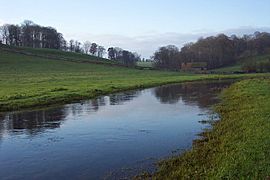River Leach facts for kids
Quick facts for kids River Leach |
|
|---|---|

Upper Leach near Eastleach Turville
|
|
| Country | England |
| Counties | Gloucestershire, Oxfordshire |
| Towns | Northleach, Lechlade |
| Physical characteristics | |
| Main source | Hampnett Gloucestershire, Cotswolds 51°41′N 1°38′W / 51.683°N 1.633°W |
| River mouth | River Thames Lechlade 51°41′21″N 1°40′38″W / 51.689053°N 1.677285°W |
| Length | 29 km (18 mi) |
The River Leach is a small but interesting river in England. It flows mostly through Gloucestershire and is a tributary to the famous River Thames. The River Leach is about 18 miles (29 km) long. It starts in the Cotswolds, an area known for its beautiful hills made of limestone.
One cool thing about the River Leach is that parts of it are a "seasonal bourn." This means the river only flows above ground when there's enough rain. During dry times, it can disappear underground! Even though it's small, the River Leach is important enough to give its name to two towns and two villages.
Contents
Where the River Leach Begins
The River Leach starts its journey in the limestone hills. After flowing for about a mile, it reaches Northleach. This is the first town named after the river. The river enters Northleach from the southwest. Here, it gushes out of a special pipe built a long time ago. People sometimes call this spot the "Seven Springs."
The very first watermill on the river was in a part of Northleach called Mill End. A section of the river here flows through stone channels. You can see it near the churchyard and behind some houses. The river then passes under a road bridge at the edge of town. At this point, it's still quite small, almost like a ditch. It continues down the valley to a tiny village called Eastington. It flows next to a lane before going under a small tunnel and into open fields.
Sometimes the River Disappears! (Seasonal Bourn)
The river then flows behind Lodge Park, which is a property managed by the National Trust. It goes through Larkethill Wood and under another lane, then past Kilkenny Farm. If you drive on the B4425 road between Cirencester and Burford, you'll notice a big dip in the road. That's the Leach valley!
Even here, the river doesn't get much bigger. In summer, it can be hard to see because of all the plants growing over it. It then passes Swyre Farm and Dean Farm. After that, it enters a very pretty, winding valley. This part of the river is often a "bourn," meaning it usually flows in winter but can dry up in summer. Sometimes, if there's a lot of rain, it can even flow in summer, which is quite unusual!
Becoming a "Real" River
Between the Westwell-Hatherop road and the villages of Eastleach Martin and Eastleach Turville, something special happens. This is where the seasonal bourn turns into a river that flows all year round! Here, you can cross the river on a stone slab clapper bridge. It's a type of bridge made of flat stones. There's also a small spring that starts near this bridge.
By the time the river reaches the Eastleach villages, it has become a "proper" river. It's several yards (or meters) wide now. The two villages are very close, with their churches just a few hundred yards apart. A road bridge and another clapper footbridge cross the river between them. The Leach then flows past another old mill between the Eastleaches and Southrop. It then goes around the small village of Fyfield. At the bridge in Southrop, the river splits into several smaller channels, which looks very nice. From Southrop onwards, the River Leach forms the border between Gloucestershire and Oxfordshire.
Meeting the Mighty Thames
As the River Leach nears its end, it passes several large old watermills. None of these mills work anymore, but they are a reminder of the river's past importance. First, there's a mill near Little Faringdon, close to Lechlade. Lechlade is the second town named after the river. Then comes Lechlade Mill, and finally Priory Mill.
Just a few hundred yards (or meters) after Priory Mill, the River Leach flows into the River Thames. It joins the Thames on the north bank, near a camping field behind The Trout Inn. It's a quiet meeting point for this small river and one of England's most famous waterways.
River Health and Water Quality
It's important to know how healthy our rivers are. The Environment Agency in England checks the water quality of rivers like the River Leach. They look at different things to see if the water is clean and safe for plants and animals.
- Ecological Status: This looks at the living things in the river, like tiny invertebrates (bugs without backbones), water plants, and fish. They check how many there are and what kinds.
- Chemical Status: This checks for different chemicals in the water. They compare the levels of these chemicals to safe limits.
By checking these things, we can understand if the river is healthy or if it needs help. This helps people work to keep our rivers clean and full of life.

